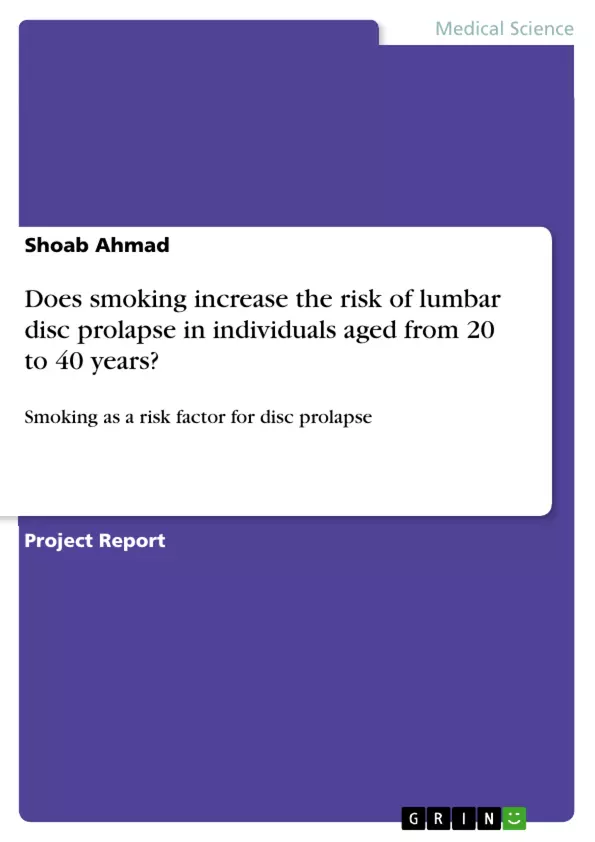Lumbar disc prolapse is one of the most common neurological conditions and there has been no agreement on its appropriate management. Lumbar disc prolapse is a very common cause of a clinical spectrum of symptoms including back pain, sciatica, knee pain and numbness, and in severe cases, nerve damage and loss of bladder and bowel control. Back pain is the most common symptom of lumbar disc prolapse and is one of the most common conditions for which a patient seeks medical attention. The primary aim of this research project is to design a protocol that estimates the effect of smoking on the risk of lumbar disc prolapse in individuals aged from 20 to 40 years.
Background
Evidence suggests that smokers have a 3-4 times higher risk of developing disc disease and that smoking can exacerbate pre-existing disc degeneration. Nicotine and other harmful toxins in cigarette smoke prevent nucleosus pulposus and annulus fibrosus cells from up taking nutrients. This can cause significant inhibition of cell proliferation and extra cellular matrix synthesis, making disc injury more likely and recovery from an injury slow. While there is strong evidence in the literature that smoking does have a role in the pathogenesis of lumbar disc prolapse and back pain, there are no accurate estimates of the magnitude of the increased risk.
Methods
Different analytical study designs were evaluated to assess their strengths, limitations and feasibility for answering the research question. Issues of subject selection, bias and measurement were assessed for case-control and cohort study designs. It was concluded that the most epidemiologically robust design would be a case-control study, which was chosen for its efficiency in time and cost.
Conclusion
A case-control study is the best design to realise the primary aim of this research protocol. Conducting the study across Australia will enable enough cases to be identified and recruiting controls from the neighborhood of the cases with simple enrolment requirements will increase the response rate and minimise the bias. Exposure measurement through face-to-face interview by trained interviewers using a structured questionnaire is cost efficient, and the use of trained interviewers ensures that participants understand the questions clearly.
Table of Contents
- Acknowledgements
- Statement of Affirmation
- Abstract
- Introduction
- Background
- Disease overview
- Anatomy of spinal disc
- Diagnosis of lumbar disc prolapse
- Management
- Risk factors for lumbar disc prolapse
- Age
- Sex
- High body mass index
- Physical workload
- Smoking
- Genetic factors
- Summary
- Issues for selecting study design
- Randomised/Non-Randomised controlled trial
- Cohort study design (prospective/retrospective)
- Case-control study design
- Issues to be considered for a case-control study
- Identifying appropriate study population
- Target population
- Source population
- Eligible population
- Study entrants
- Study participants
- Study sample size
- Data collection
- Sample questionnaire
- Potential sources of bias
- Potential confounders
- Statistical analysis
- Ethical issues
- Discussion and conclusions
- References
Objectives and Key Themes
This research project aims to design a protocol that estimates the effect of smoking on the risk of lumbar disc prolapse in individuals aged from 20 to 40 years.
- The prevalence and incidence of lumbar disc prolapse.
- The impact of smoking on lumbar disc health.
- The identification and evaluation of potential risk factors for lumbar disc prolapse.
- The determination of the most appropriate study design for investigating the relationship between smoking and lumbar disc prolapse.
- The development of a comprehensive research protocol for a case-control study.
Chapter Summaries
- Chapter 1: Introduction - This chapter provides an overview of lumbar disc prolapse, its prevalence, and its associated symptoms. It also highlights the need for further research to understand the disease's epidemiology and develop effective prevention and management strategies.
- Chapter 2: Background - This chapter delves deeper into the nature of lumbar disc prolapse, outlining its anatomy, diagnosis, and management. It explores various risk factors for lumbar disc prolapse, including age, sex, high body mass index, physical workload, smoking, and genetic factors.
- Chapter 3: Issues for Selecting Study Design - This chapter discusses the strengths and limitations of different study designs, including randomized controlled trials, cohort studies, and case-control studies, in the context of investigating the relationship between smoking and lumbar disc prolapse.
- Chapter 4: Issues to be Considered for a Case-Control Study - This chapter focuses on the specific details of a case-control study design, outlining the identification of appropriate study populations, sample size calculations, data collection methods, potential sources of bias, and potential confounders.
- Chapter 5: Statistical Analysis - This chapter details the proposed statistical analysis techniques for the case-control study, including univariate and multiple logistic regression, to estimate the odds ratio for the association between smoking and lumbar disc prolapse.
- Chapter 6: Ethical Issues - This chapter discusses the ethical considerations for conducting the research, including informed consent, potential harms and benefits, privacy, and the right to withdraw.
Keywords
The primary focus of this research project is on the relationship between smoking and lumbar disc prolapse. The study examines the prevalence and incidence of lumbar disc prolapse, investigates the effect of smoking on disc health, and identifies potential risk factors associated with the condition. Key terms and concepts include: lumbar disc prolapse, back pain, smoking, risk factors, case-control study, odds ratio, confounders, epidemiology, aetiology, and public health.
- Quote paper
- Shoab Ahmad (Author), 2012, Does smoking increase the risk of lumbar disc prolapse in individuals aged from 20 to 40 years?, Munich, GRIN Verlag, https://www.grin.com/document/321593



